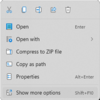- Local time
- 1:05 PM
- Posts
- 752
- OS
- Windows 11
Although the concept of Virtual Machine has existed for a long time, it is only used by a tiny fraction of individuals for personal use. The reasons are usually one of the following:
1. Lack of awareness
2. Low system specs
3. No requirement
I have never used it myself until very recently. In my case, it is reason 1 for the most part, and then reason 2 for the remaining part. But now when I started using it, it came as a big surprise with regards to how well it runs on an old machine. I have a 2013 laptop, which at the time of purchase had the best of specs, but with all the advancements in technology and demands of newer operating systems, made me think that it won't be able to provide a great experience. I was wrong!
I have installed macOS Monterey on VMware and Windows 10 on VirtualBox on my host OS which is Windows 11. Both guest OSes run surprisingly smoothly.
1. As an individual end user, what do YOU use the VM for?
2. Is it true that activities inside a VM like VirtualBox cannot be tracked by Microsoft?
.
1. Lack of awareness
2. Low system specs
3. No requirement
I have never used it myself until very recently. In my case, it is reason 1 for the most part, and then reason 2 for the remaining part. But now when I started using it, it came as a big surprise with regards to how well it runs on an old machine. I have a 2013 laptop, which at the time of purchase had the best of specs, but with all the advancements in technology and demands of newer operating systems, made me think that it won't be able to provide a great experience. I was wrong!
I have installed macOS Monterey on VMware and Windows 10 on VirtualBox on my host OS which is Windows 11. Both guest OSes run surprisingly smoothly.
1. As an individual end user, what do YOU use the VM for?
2. Is it true that activities inside a VM like VirtualBox cannot be tracked by Microsoft?
.
Last edited:
My Computer
System One
-
- OS
- Windows 11
- Computer type
- Laptop
- Manufacturer/Model
- HP Envy dv7
- CPU
- Intel Core i7 3630QM
- Motherboard
- HP
- Memory
- 16 GB
- Graphics Card(s)
- Intel HD Graphics 4000 & Nvidia GeForce GT 635M
- Sound Card
- IDT High Definition
- Screen Resolution
- 1080p
- Hard Drives
- 1 TB Crucial MX500 on bay 1.
1 TB Seagate HDD on bay 2.
- Antivirus
- Windows Defender


















